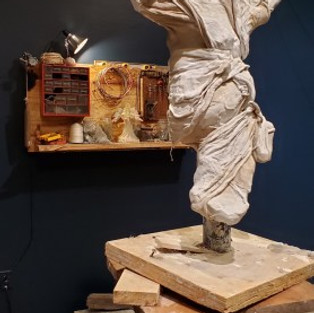
Parris Patton, Sculpture, Good Luck Gallery; Photo credit Betty Ann Brown
Memory, Fragmentation & Ruins in the Art of Parris Patton
“A ruin never actually shows itself, but rather points beyond itself to that of which it is a mere remnant. In the ruin is manifest the fragility of the process of production; not so much the permanence of the products of human production as human powerlessness in the face of the power of time.” ~ Irish philosopher Felix O Murchadha
Good Luck Gallery, Los Angeles through May 26
Written by Betty Ann Brown Parris Patton has transformed the Good Luck Gallery into an artistic memory palace and populated it with 15 freestanding sculptures and two mixed media reliefs. A memory palace was, for the Ancient Greeks and Romans, an imaginary space in your mind where you could store mnemonic images. Patton’s exhibition is like a three-dimensional map of societal memories, arranged in post-apocalyptic display.
Walking through the space is a bit like touring the Acropolis in Athens: Although there are glorious indications of past existence, it is now in ruins and most of the elements are fragmentary, dislocated, and scattered across space and time. Two of Patton’s sculptures specifically recall the Winged Victory of Samothrace, an immense Hellenistic figure that now dominates a stairwell in the Louvre Museum. The Greek Victory has lost both her arms and her head–yet she maintains an extraordinary power and grace. Patton’s versions are smaller and more disjointed. Indeed, they might be mistaken for inchoate blobs if encountered outside an art venue. But in the handsome, midnight blue gallery, elevated on the artist’s makeshift plinths and elegantly illuminated, aesthetic resonances are undeniably evoked.
These resonances are amplified by other works with overt “high art” allusions: There are several angels, a relief “portrait” of Oberon (the character from Shakespeare’s A Midsummer Night’s Dream), and a fountain starring Picasso. (I leave it to the reader to guess where the water comes from. Hint: Think about Marcel Duchamp’s 1917 Fountain.) The “high art” references of many of the sculptures are complicated by the kitschy impact of others. There’s a duck wearing a kimono, two garden gnomes, and a fake deer head framed by Christmas lights. (Alas, I can’t write the word “kitschy” without thinking of Jeff Koons. But Patton’s work, with its earnest, de-skilled surfaces, is the antithesis of Koons’ slick commercial gloss.)
Patton’s oeuvre has a funky, unfinished quality that compels viewers to focus on the process of creation, rather than solely on the final product. Many of the sculptures are composed of plaster, which is to say, the gypsum-based Plaster of Paris. (Remember: Plaster walls were the preferred painting surfaces in the Ancient World. And the artist’s first name is Parris, which can be traced back to its ancient origins. The Greek Paris was son of the King of Troy. His abduction of the Queen of Sparta led to the Trojan War.)
Patton is so enamored with the process of plaster casting that he often displays the mold itself alongside the finished sculpture. “Pissing Picasso Mold” — the prototype for the larger fountain–depicts the famed painter as a miniature silicone shape. “Angel 3” is paired with its mold. (The white ropes that wind around the mold recall Christo’s early works, such as the wrapped and tied Packages from 1958-61.) In one case, Patton is exhibiting only the mold. His “Plaster Maiden” is the mold for a female torso, its head indicated by the orange silicone lining the upper part of the plaster body. The two halves of the mold are attached with a large metal clamp, its implied violence recalling the medieval torture device known as an Iron Maiden.
Writing about the ideas of German philosopher Martin Heidegger, US scholar Iain Thompson has summarized, “Great art works by selectively focusing an historical community’s tacit sense of what is and what matters and reflecting it back to that community, which thereby comes implicitly to understand itself in the light of this artwork. Artworks thus function as ontological paradigms, serving their communities both as ‘models of’ and ‘models for’ reality.” Parris Patton’s art works by turning our awareness to how art embodies and articulates our community’s historical memory in physical artifacts, even if/when those artifacts are fragmentary and in ruins.
(Postscript: Ruins may allow for more wide-ranging projections on the part of the viewer than perfectly whole artifacts–but that’s the subject of another essay.)
Good Luck Gallery 945 Chung King Rd, Los Angeles, 90012
#losangeles #california #losangelesartist #art #painting #shoeboxpr #laverne #ParrisPatton #GoodLuckGallery #losangelesart #contemporaryart #southerncalifornia #abstract #collage #artgallery #kristineschomaker #artinterview #gallery #museum #artandcake #artexhibition #installation #fineart #bettyannbrown #artist #soloshow #mixedmedia #arts #artreview #artmagazine #ArtandCulture #exhibition #exhibit


































